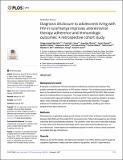| dc.contributor.author | Gregg Joseph Montalto, Fredrick K Sawe, Argwings Miruka, Jonah Maswai, Ignatius Kiptoo, Appolonia Aoko, Chrispine Oreyo, Eunice Obiero, Sheila Korir, Stephen K Bii, Katherine X Song, Anjali N Kunz | |
| dc.date.accessioned | 2022-01-23T11:33:20Z | |
| dc.date.available | 2022-01-23T11:33:20Z | |
| dc.date.issued | 2017 | |
| dc.identifier.uri | https://repository.maseno.ac.ke/handle/123456789/4583 | |
| dc.description.abstract | Background & aims Emphasis on adolescent HIV has increased worldwide as antiretroviral treatment has greatly extended life expectancies of HIV-positive children. Few evidence-based guidelines exist on the optimal time to disclose to an adolescent living with HIV (ALHIV); little is known about the medical effects of disclosure. This study looked to determine whether disclosure is associated with improved medical outcomes in ALHIV. Prior work has tended to be qualitative, cross-sectional, and with an emphasis on psychosocial outcomes. This paper addresses the adolescent cohort retrospectively (longitudinally), building upon what is already known about disclosure. Methods Retrospective, longitudinal clinical record reviews of ALHIV seen at Kericho District Hospital between April 2004 and November 2012 were performed. Patient demographics and clinical outcomes were systematically extracted. The student’s t-test was used to calculate changes in mean CD4 count, antiretroviral therapy (ART), and cotrimoxazole adherence pre- vs. post-disclosure. Linear regression modelling assessed for trends in those clinical outcomes associated with age of disclosure. Results Ninety-six ALHIV (54 female, 42 male) were included; most (73%) entered care through the outpatient department. Nearly half were cared for by parents, and 20% experienced a change in their primary caregiver. The mean time in the study was 2.47 years; mean number of visits 10.97 per patient over the mean time in the study. Mean disclosure age was 12.34 years. An increase in mean ART adherence percentage was found with disclosure (0.802 vs. 0.917; p = 0.0015). Younger disclosure age was associated with significantly higher mean CD4 counts over the course of the study (p = 0.001), and a nonsignificant trend toward a higher mean ART adherence percentage (p = 0.055). Conclusion ART adherence and improved immunologic status are both associated with disclosure of HIV infection to adolescent patients. Disclosure of an HIV diagnosis to an adolescent is an important means to improve HIV care. | en_US |
| dc.publisher | Public Library of Science | en_US |
| dc.title | Diagnosis disclosure to adolescents living with HIV in rural Kenya improves antiretroviral therapy adherence and immunologic outcomes: A retrospective cohort study | en_US |
| dc.type | Article | en_US |

